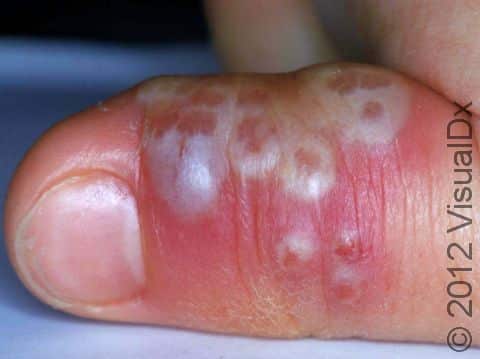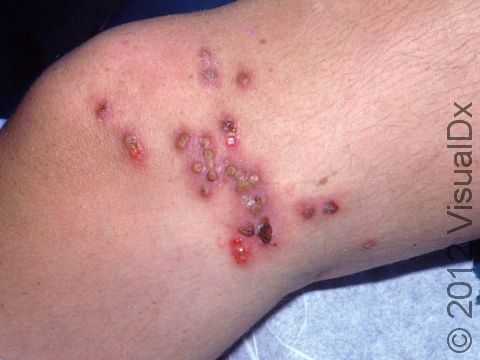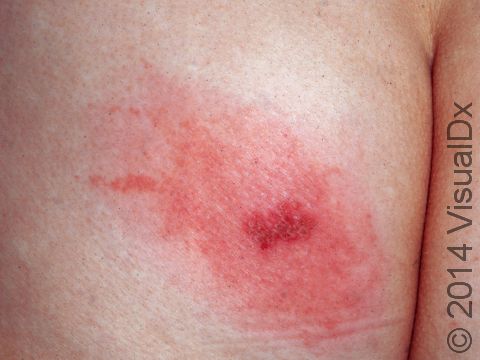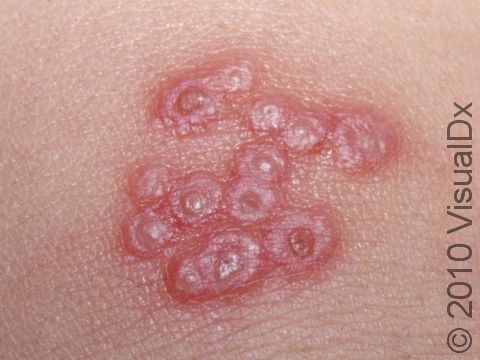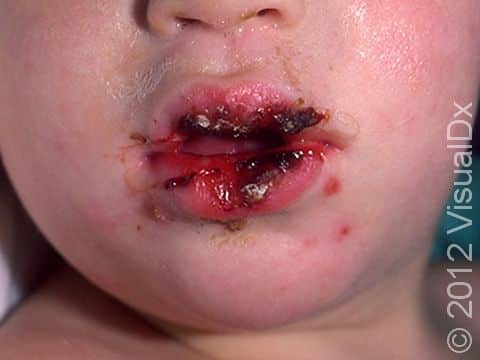Herpes Simplex Virus (HSV)
Herpes simplex virus (HSV) is a common infection that can cause skin or mouth sores, the latter of which are often called cold sores or fever blisters. The first eruption, or outbreak, is called primary herpes. This is often more severe than secondary, or recurrent, herpes infections.
Both herpes simplex virus type 1 (HSV-1) and herpes simplex virus type 2 (HSV-2) can cause infection. HSV-1 is the most common cause of lesions that appear around the mouth and on the lips. HSV-2 more commonly causes lesions on the genital area, although HSV-1 can also be a cause. HSV-2 can more rarely occur on virtually any body surface. HSV is highly contagious and is spread by direct contact with the lesions of another infected individual, such as a playmate, parent, or caretaker. The virus can even spread in the absence of symptoms or visible lesions.
The primary herpes episode usually heals in 7-10 days. Affected individuals carry the virus in their bodies for the rest of their lives, and this may lead to recurrences of outbreaks in the same skin area. Most people report burning, itching, and a tingling sensation in the area before the actual lesions appear.
Who's At Risk?
Infection with HSV is very common. Most people never even know they have been infected, as their immune system suppresses symptoms. At least one-third of children are infected by HSV by the end of childhood.
HSV infection may be more severe in newborns and in those with a weak immune system.
Signs & Symptoms
Most commonly, primary herpes in children involves painful blisters and erosions of the gums and the skin around or lining the mouth. There may also be fever, swollen lymph nodes in the neck, irritability, and a poor appetite. If HSV is introduced on another body site, there may be painful blisters and sores in that location (eg, the finger, face, genitals), with swelling and similar symptoms affecting the entire body, such as fever and swollen lymph nodes.
Self-Care Guidelines
- You can give acetaminophen (Tylenol) or ibuprofen (Advil, Motril) for the pain. It is important to relieve pain so that eating and sleeping are possible.
- The child should be encouraged to drink as much fluid as possible to avoid dehydration.
- Avoid contact with other children, especially newborns and those with eczema or a weak immune system, until healed.
Treatments
Antiviral medications may be prescribed, including acyclovir (Zovirax) or valacyclovir (Valtrex; only in children ages 12 years and older). Anesthetic mouthwashes or pain medication may be given to reduce pain. Sometimes a child will need to be given intravenous fluids for dehydration.
Visit Urgency
Although those with mild recurrent herpes do not usually require any medical care, see your child’s medical professional if you think they have primary herpes or if your child has recurrent herpes with bothersome symptoms.
Trusted Links
References
Bolognia J, Schaffer JV, Cerroni L. Dermatology. 4th ed. Philadelphia, PA: Elsevier; 2018.
James WD, Elston D, Treat JR, Rosenbach MA. Andrew’s Diseases of the Skin. 13th ed. Philadelphia, PA: Elsevier; 2019.
Kang S, Amagai M, Bruckner AL, et al. Fitzpatrick’s Dermatology. 9th ed. New York, NY: McGraw-Hill Education; 2019.
Paller A, Mancini A. Paller and Mancini: Hurwitz Clinical Pediatric Dermatology. 6th ed. St. Louis, MO: Elsevier; 2022.
Last modified on June 14th, 2024 at 9:46 am

Not sure what to look for?
Try our new Rash and Skin Condition Finder

